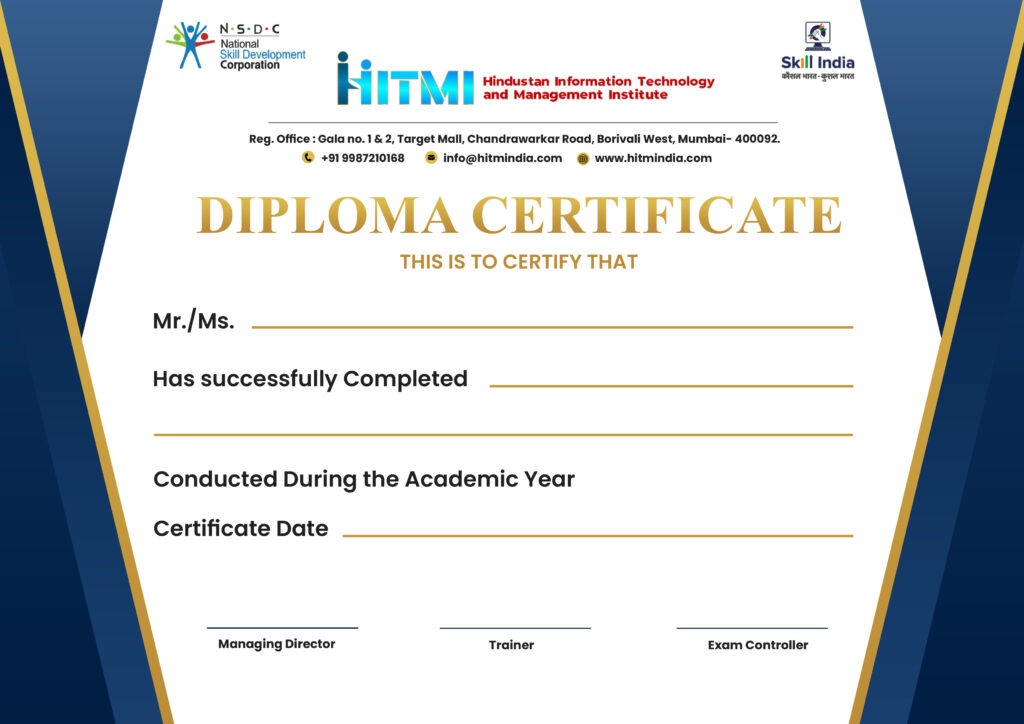- Home
- About Us
- Our Courses
- Data Science
- Machine Learning
- Cyber Security
- Cloud Computing
- Artificial Intelligence
- Become a Partner
- Careers
- Contact Us
- Blog
Enroll in HITMI’s premier Diploma in Graphic and Web Designing and enhance your expertise as a skilled website developer and graphic designer. Through our interactive training, you’ll gain proficiency in both front-end and back-end technologies crucial for crafting dynamic websites and engaging web applications.
Experience a plethora of advantages, including participation in over 10 real-world design and development projects, access to industry-recognized certification programs, personalized mentorship from seasoned professionals, and more with HITMI’s comprehensive Diploma in Graphic and Web Designing. Enquire today and embark on your journey towards achieving professional excellence!
The Diploma in Graphic and Web Designing offered at HITMI is a comprehensive program that combines the essential skills of graphic design with the fundamentals of web development. Designed to equip students with a holistic understanding of visual communication and digital presence creation, this diploma course covers a wide range of topics essential for success in the dynamic fields of graphic design and web development.
Throughout the program, students delve into the intricacies of graphic design, learning about design principles, color theory, typography, and visual hierarchy. They develop proficiency in industry-standard graphic design software, gaining hands-on experience in creating visually engaging materials such as logos, brochures, posters, and digital graphics.
Simultaneously, students explore the realm of web development, mastering front-end technologies including HTML, CSS, and JavaScript. They learn to design and develop responsive, user-friendly websites that meet modern design standards and user expectations. Additionally, students delve into back-end tools such as PHP and MySQL, enabling them to create dynamic and interactive web applications.
Taught by seasoned industry professionals, the Diploma in Graphic and Web Designing emphasizes practical learning through hands-on projects. Students work on real-world design briefs and web development tasks, honing their skills and building a professional portfolio that showcases their abilities to potential employers.
By the end of the diploma course, graduates emerge as well-rounded professionals proficient in both graphic design and web development. Armed with the latest tools, frameworks, and techniques, they are prepared to embark on successful careers in the thriving fields of graphic and web design, ready to make a meaningful impact in the industry. Join HITMI’s Diploma in Graphic and Web Designing today to unlock your potential and kickstart a rewarding career in visual communication and digital media.

Our curriculum is meticulously crafted to encompass a well-structured and comprehensive approach, aligning with the latest trends and adhering strictly to industry standards.

Our program gives you lots of practical skills and knowledge for real-world situations. You'll work on real projects and tasks to learn effectively.

Explore HITMI's commitment to securing your career with us. Take the opportunity to experience our quality training firsthand & gain confidence in our 100% job assurance

Get valuable guidance and unwavering support from experienced mentors who are dedicated to assisting you throughout your journey to success.

Our approach is practical, offering hands-on experience with live, interactive training. This lets you utilize what you learn in real-time situations.

Our emphasis lies in honing practical skills and enhancing real-world capabilities. You'll engage in live projects, crafting a strong portfolio for your future career pursuits.

Upon successfully finishing our course, you'll receive a widely recognized certification, paving the way for numerous career opportunities in India and globally.





You will learn graphic design principles, web design fundamentals, and how to use tools like Adobe Photoshop, Illustrator, and web design software.
Yes, this course is suitable for beginners as well as those looking to enhance their design skills.
The course typically spans six months.
Yes, the course includes project work that will help you create a professional portfolio.
Yes, we offer job placement assistance, including resume building and interview preparation.
There are no prerequisites; anyone with an interest in graphic and web design can enroll.
Yes, you will receive a diploma certificate upon successful completion of the course.
